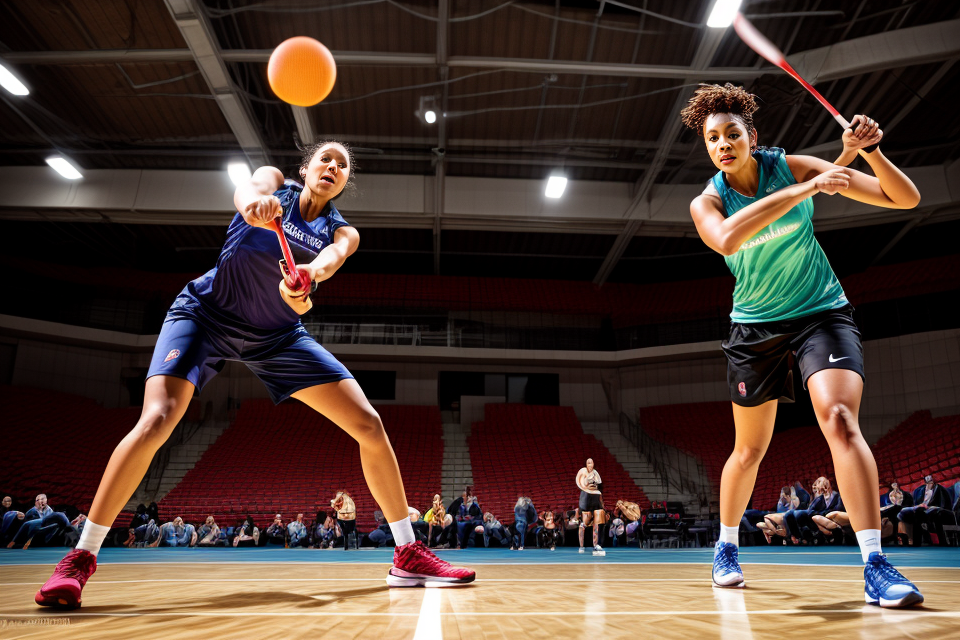Squash is a physically demanding sport that requires both strength and endurance. One of the most crucial aspects of squash is having good stamina, which allows you to keep going for long rallies without getting tired. In this article, we will explore effective training and drills that can help you improve your stamina for squash. We will cover topics such as cardiovascular exercises, strength training, and specific drills that target the muscles used in squash. By incorporating these exercises into your training routine, you can improve your stamina and become a more competitive player on the court. So, let’s get started and learn how to improve your stamina for squash!
Understanding Stamina in Squash
The Importance of Stamina in Squash
In the fast-paced sport of squash, stamina is a crucial aspect that separates skilled players from novices. It is the ability of the body to sustain high-intensity physical activity for an extended period, enabling players to perform at their best throughout the match. Stamina is especially important in squash because of the sport’s unique characteristics, such as:
- The small court size: The court’s dimensions require players to move continuously and make quick directional changes, which can be tiring.
- The high intensity: Squash is an aerobic and anaerobic sport, meaning it demands both short bursts of energy and long-term endurance.
- The diverse skills: Squash involves a range of physical and mental skills, including speed, agility, power, and strategic thinking, all of which contribute to the overall demand for stamina.
A lack of stamina can lead to fatigue, decreased performance, and increased risk of injury. On the other hand, a well-developed stamina can help players maintain a consistent level of intensity, prevent exhaustion, and improve their overall game.
Moreover, stamina is not only essential for individual players but also for doubles teams. In doubles squash, players need to work together and rely on each other’s strengths, which requires them to be in sync and maintain their stamina throughout the match.
In conclusion, the importance of stamina in squash cannot be overstated. It is a critical factor that affects a player’s ability to perform at their best and maintain their level of play throughout the match. By incorporating effective training and drills, players can significantly improve their stamina and enhance their overall performance on the squash court.
Factors Affecting Stamina in Squash
Squash is a physically demanding sport that requires players to be in excellent physical condition. One of the most important aspects of physical fitness for squash players is stamina. Stamina refers to the ability of the body to sustain physical activity for an extended period of time. In squash, stamina is essential for maintaining a high level of intensity and endurance throughout the game.
There are several factors that can affect stamina in squash. These include:
- Fitness level: Players who are in better physical shape tend to have higher levels of stamina. This is because they have a higher capacity for aerobic and anaerobic exercise, which are both important for sustained physical activity.
- Aerobic capacity: Aerobic exercise is essential for building stamina in squash. Aerobic capacity refers to the body’s ability to efficiently utilize oxygen during physical activity. Players with higher aerobic capacity are able to sustain high-intensity physical activity for longer periods of time.
- Muscle endurance: Squash involves a lot of movement, and players need to have strong, enduring muscles to keep going. Muscle endurance can be improved through strength training and endurance exercises.
- Mental toughness: Squash is a mentally demanding sport, and mental toughness is crucial for maintaining stamina. Players who are mentally tough are better able to push through physical fatigue and maintain a high level of intensity throughout the game.
- Nutrition and hydration: Proper nutrition and hydration are essential for maintaining stamina during physical activity. Players should focus on consuming a balanced diet that includes plenty of carbohydrates, protein, and healthy fats to fuel their bodies during the game. Hydration is also important, and players should make sure to stay well-hydrated throughout the game.
By understanding the factors that affect stamina in squash, players can develop targeted training programs to improve their physical fitness and maintain a high level of intensity throughout the game.
Improving Cardiovascular Endurance
Aerobic Exercises for Stamina
Aerobic exercises are an essential component of any endurance training program. These exercises are designed to improve cardiovascular endurance, which is crucial for squash players as it helps them to maintain high levels of intensity throughout a match. The following are some of the most effective aerobic exercises for improving stamina in squash players:
- Running: Running is one of the most effective aerobic exercises for improving cardiovascular endurance. Squash players can incorporate interval training, such as sprints and hill sprints, into their running routine to increase the intensity of their workouts.
- Cycling: Cycling is another excellent aerobic exercise that can help squash players to improve their cardiovascular endurance. Indoor cycling classes or outdoor cycling routes can provide a challenging workout that can help players to build up their stamina.
- Swimming: Swimming is a low-impact exercise that is easy on the joints and can help to improve cardiovascular endurance. Squash players can incorporate swimming into their training program to build up their stamina and endurance.
- Rowing: Rowing is a high-intensity, full-body workout that can help to improve cardiovascular endurance. Squash players can use rowing machines or participate in group rowing classes to build up their stamina.
- Jumping rope: Jumping rope is a high-intensity exercise that can help to improve cardiovascular endurance and coordination. Squash players can incorporate jump rope exercises into their training program to build up their stamina and agility.
Incorporating these aerobic exercises into a training program can help squash players to improve their cardiovascular endurance, which is essential for maintaining high levels of intensity throughout a match. It is important to note that while these exercises are effective, they should be performed with proper form and at an appropriate intensity level to avoid injury.
Interval Training for Squash
Interval training is a highly effective method for improving cardiovascular endurance in squash players. It involves alternating periods of high-intensity exercise with periods of rest or low-intensity exercise. This type of training has been shown to improve overall fitness, increase energy levels, and enhance endurance on the squash court.
In squash, interval training can be performed in a variety of ways. One popular method is to use the “bleep test,” which involves running between two lines on the court, as fast as possible, when a whistle blows. This drill can be performed with a partner, who will blow the whistle at different intervals, ranging from 30 seconds to several minutes. The goal is to improve the player’s ability to sustain high-intensity exercise for extended periods of time.
Another interval training method for squash is to perform sprints on the court. This can be done by marking off a distance of 10-20 yards on the court and sprinting to the end of the line, resting for a short period of time, and then repeating the sprint. This drill can be performed for several repetitions, with the goal of increasing the number of repetitions over time.
Interval training can also be incorporated into a full squash match simulation. For example, a player can play a match, but instead of playing continuously, they take short breaks between points or games. The breaks can be longer or shorter, depending on the player’s fitness level and the intensity of the match.
Overall, interval training is a highly effective method for improving cardiovascular endurance in squash players. It can be incorporated into a variety of drills and simulations, and can help players to sustain high-intensity exercise for extended periods of time on the squash court.
Resistance Training for Cardiovascular Health
In addition to aerobic exercises, resistance training can also help improve cardiovascular health and endurance in squash players. Resistance training can increase muscle strength and endurance, which can help players maintain a higher intensity of play for longer periods of time. Here are some examples of resistance training exercises that can be incorporated into a training program for squash players:
- Weightlifting: Weightlifting exercises such as bicep curls, tricep extensions, and shoulder presses can help build muscle strength and endurance in the upper body, which is crucial for hitting powerful shots and maintaining good form during play.
- Squats: Squats are a great exercise for building leg strength and endurance, which is essential for quick footwork and explosive movements on the court.
- Jump training: Jump training exercises such as box jumps and plyometric lunges can help improve leg power and explosiveness, which can help players make quick moves and reach for difficult shots.
- Core training: Core training exercises such as planks and Russian twists can help improve core stability and balance, which can help players maintain proper form and prevent injuries during play.
It’s important to note that resistance training should be done in moderation and with proper supervision, especially for young or inexperienced players. Overdoing it can lead to injury and overtraining. Additionally, it’s important to focus on functional strength training exercises that target the muscles used during squash play, rather than just lifting heavy weights for the sake of doing so.
By incorporating resistance training into their training program, squash players can improve their cardiovascular endurance and overall fitness level, which can help them perform at their best on the court.
Strength Training for Stamina
Targeted Muscle Groups for Squash
As a professional squash player, it is crucial to ensure that your muscles are in optimal condition to support your performance on the court. To achieve this, you need to focus on targeted muscle groups that are essential for squash. These muscle groups include:
- Core muscles: Your core muscles are responsible for stabilizing your body and transferring power from your lower body to your upper body. They include the abdominal muscles, lower back muscles, and muscles in the pelvic region.
- Leg muscles: Leg muscles, particularly the quadriceps, hamstrings, and calf muscles, provide the power needed for jumping, running, and changing direction on the court.
- Upper body muscles: The upper body muscles, including the arms, shoulders, and chest muscles, are responsible for maintaining balance, controlling the racket, and executing shots with precision.
To improve your stamina for squash, it is important to train these muscle groups separately and as a whole. You can achieve this by incorporating exercises such as planks, crunches, lunges, squats, push-ups, and bench press into your training routine. Additionally, you can incorporate plyometric exercises, such as box jumps and bounding, to improve your power and explosiveness on the court.
Compound Exercises for Overall Stamina
Improving stamina for squash requires a well-rounded fitness routine that targets multiple muscle groups. Compound exercises are a great way to achieve this by working multiple muscles at once. These exercises not only improve overall stamina but also help build strength, endurance, and muscular balance.
Some of the most effective compound exercises for improving stamina in squash include:
- Squats: This exercise works the legs, glutes, and core, making it an excellent choice for improving overall stamina.
- Deadlifts: This exercise targets the hamstrings, glutes, and lower back, which are all crucial for squash performance.
- Lunges: Lunges are a unilateral exercise that works the legs, glutes, and core, helping to improve balance and stability.
- Push-ups: This exercise targets the chest, shoulders, and triceps, helping to improve upper body strength and endurance.
- Bench press: This exercise works the chest, shoulders, and triceps, helping to improve overall upper body strength and endurance.
Incorporating these compound exercises into your fitness routine can help improve your stamina for squash by building overall strength, endurance, and muscular balance. It’s important to remember that proper form and technique are crucial when performing these exercises to avoid injury and maximize results. Additionally, it’s recommended to start with lighter weights and gradually increase the load as you build strength and endurance.
Flexibility and Mobility Training
Stretching and Flexibility Exercises
Proper flexibility and mobility training is crucial for improving stamina in squash. Here are some effective stretching and flexibility exercises that can help you improve your range of motion and reduce the risk of injury:
Dynamic Stretching
Dynamic stretching involves moving stretched muscles through their full range of motion. This type of stretching is ideal for warming up before a game and can help increase blood flow to the muscles, improving their ability to perform at a high level. Examples of dynamic stretches for squash include leg swings, arm circles, and hip rotations.
Static Stretching
Static stretching involves holding a stretch for a set period of time to elongate the muscle fibers. This type of stretching is ideal for cooling down after a game and can help improve flexibility and reduce the risk of injury. Examples of static stretches for squash include hamstring stretches, quadricep stretches, and calf stretches.
Flexibility Exercises
In addition to stretching, there are several flexibility exercises that can help improve your range of motion and reduce the risk of injury. These exercises include:
- Foam rolling: Using a foam roller to massage tight muscles and increase flexibility.
- Pigeon stretch: A yoga pose that stretches the hips, glutes, and quads.
- Butterfly stretch: A stretch for the inner thighs that can help improve balance and stability.
- Cobra stretch: A backbend that stretches the chest, shoulders, and back.
By incorporating these stretching and flexibility exercises into your training routine, you can improve your overall stamina and reduce the risk of injury, allowing you to perform at your best on the squash court.
Mobility Drills for Squash
As a crucial aspect of physical fitness, mobility training plays a significant role in enhancing one’s overall performance in squash. Mobility drills for squash can help increase flexibility, improve balance, and reduce the risk of injury. Incorporating these exercises into your training routine can lead to improved movement and greater efficiency on the court.
Some effective mobility drills for squash include:
- Dynamic stretching: Engaging in dynamic stretching exercises such as leg swings, arm circles, and hip openers can help improve range of motion and increase blood flow to the muscles. These exercises should be performed with control and a focus on proper form to ensure maximum benefit.
- Balance exercises: Improving balance is essential in squash, as it requires quick movements and changes of direction. Exercises such as single-leg squats, single-leg deadlifts, and single-leg balance can help increase stability and improve overall balance.
- Mobility drills specific to squash: Specific drills such as the “t-drill” and “l-drill” can help improve mobility and footwork in squash. These drills involve moving laterally and diagonally while maintaining balance and control.
Incorporating these mobility drills into your training routine can help improve your overall performance in squash by increasing flexibility, balance, and reducing the risk of injury. It is important to perform these exercises with proper form and control to ensure maximum benefit.
Nutrition and Recovery
Proper Hydration for Stamina
Hydration is crucial for athletes, including squash players, as it helps maintain optimal physical performance and prevents dehydration-related injuries. Proper hydration before, during, and after a game can significantly improve stamina and overall athletic performance. Here are some key points to consider when it comes to proper hydration for squash players:
- Timing: Hydration should be strategically timed to ensure that the player is well-hydrated before the game, maintains proper hydration levels during the game, and replenishes fluids lost during the game.
- Fluid Intake: Players should consume water or sports drinks containing electrolytes to maintain hydration levels. The American College of Sports Medicine recommends that athletes consume 500-700 ml of water or sports drink two to three hours before the game, and 200-300 ml every 15-20 minutes during the game.
- Monitoring: Players should monitor their hydration levels by checking the color of their urine. If it’s clear or pale yellow, they are well-hydrated. If it’s dark yellow or amber, they need to drink more fluids.
- Pre-game meal: Players should consume a balanced meal containing carbohydrates and protein two to three hours before the game to provide sustained energy and support muscle recovery.
- Post-game recovery: After the game, players should consume fluids containing electrolytes and a balanced meal within 30 minutes to an hour to replenish lost fluids and restore energy stores.
In addition to proper hydration, players should also consider the type of fluids they consume. Sports drinks containing electrolytes, such as sodium and potassium, can help replace essential minerals lost during physical activity. However, players should avoid consuming sugary drinks or caffeinated beverages, as they can have a negative impact on hydration levels and energy levels.
By prioritizing proper hydration, squash players can improve their stamina and prevent dehydration-related injuries. Hydration should be a key component of a player’s overall nutrition and recovery plan, along with a balanced diet, adequate rest, and proper training.
Post-Workout Recovery Strategies
Effective post-workout recovery strategies are essential for athletes to optimize their performance and avoid injury. Here are some strategies that can help improve stamina for squash:
- Hydration: Proper hydration is crucial for recovery and overall health. It is recommended to drink at least 8-10 glasses of water per day. Drinking water before, during, and after exercise helps maintain hydration levels and prevents dehydration.
- Nutrient-rich diet: Consuming a balanced diet that includes nutrient-rich foods such as fruits, vegetables, whole grains, lean proteins, and healthy fats is important for optimal performance. These foods provide the necessary nutrients for energy production, muscle repair, and overall health.
- Protein intake: Protein is essential for muscle repair and growth. It is recommended to consume protein-rich foods such as chicken, fish, beans, and nuts within 30 minutes of exercise to aid in muscle recovery.
- Rest and recovery: Adequate rest and recovery time is crucial for athletes to avoid injury and improve performance. It is recommended to allow at least 24-48 hours of rest between high-intensity workouts.
- Active recovery: Active recovery, such as light exercise or stretching, can help reduce muscle soreness and improve circulation.
- Massage therapy: Massage therapy can help improve circulation, reduce muscle soreness, and promote relaxation.
- Compression garments: Wearing compression garments, such as socks or sleeves, can help reduce muscle soreness and improve circulation.
- Cold and heat therapy: Cold therapy, such as ice packs, can help reduce inflammation and pain, while heat therapy, such as hot tubs or heating pads, can help improve circulation and reduce muscle stiffness.
- Stretching and foam rolling: Stretching and foam rolling can help improve flexibility, reduce muscle soreness, and promote relaxation.
- Sleep: Adequate sleep is crucial for recovery and overall health. It is recommended to get at least 7-9 hours of sleep per night.
By incorporating these post-workout recovery strategies into their routine, athletes can improve their stamina for squash and optimize their performance.
Incorporating Stamina Training into Your Squash Routine
Developing a Squash Training Plan
To effectively improve your stamina for squash, it is essential to develop a comprehensive training plan that includes both cardiovascular and strength training exercises. Here are some steps to help you create a personalized squash training plan:
- Assess Your Current Fitness Level: Before starting any training program, it is important to assess your current fitness level. This will help you determine the appropriate intensity and duration of your workouts. You can consult with a fitness professional or take a fitness test to measure your heart rate, blood pressure, and lung function.
- Set Realistic Goals: Based on your fitness assessment, set realistic goals for your squash training. Your goals should be specific, measurable, achievable, relevant, and time-bound (SMART). For example, you may want to increase your endurance by 20% within the next three months or reduce your rest time between rallies by 30 seconds.
- Develop a Training Schedule: Develop a training schedule that includes both cardiovascular and strength training exercises. Cardiovascular exercises such as running, cycling, or swimming should be done at least three times a week for 30-60 minutes per session. Strength training exercises such as weightlifting or bodyweight exercises should be done twice a week for 30-45 minutes per session.
- Incorporate Squash-Specific Drills: Incorporate squash-specific drills into your training schedule to improve your technical skills and overall game performance. Drills such as footwork exercises, stroke development, and ball control drills should be done at least two times a week for 20-30 minutes per session.
- Gradually Increase Intensity and Duration: Gradually increase the intensity and duration of your workouts over time. This will help your body adapt to the demands of squash and improve your overall stamina. Start with shorter workouts at a lower intensity and gradually increase the duration and intensity over time.
- Rest and Recover: Rest and recovery are crucial for improving your stamina and preventing injury. Make sure to include adequate rest days in your training schedule and incorporate recovery techniques such as stretching, foam rolling, and massage.
By following these steps, you can develop a personalized squash training plan that will help you improve your stamina and overall game performance. Remember to listen to your body, stay hydrated, and seek professional guidance if necessary.
Tracking Progress and Adjusting Your Training
One of the key aspects of improving stamina for squash is to track your progress and adjust your training accordingly. By monitoring your progress, you can determine the effectiveness of your training and make any necessary changes to optimize your performance. Here are some tips for tracking progress and adjusting your training:
- Set realistic goals: Setting realistic goals is crucial when it comes to tracking progress and adjusting your training. Make sure your goals are specific, measurable, achievable, relevant, and time-bound (SMART). For example, instead of setting a vague goal like “improve your stamina,” you could set a specific goal like “increase your squash court coverage by 10% in the next 8 weeks.”
- Use a training log: Keeping a training log is an effective way to track your progress and identify areas for improvement. A training log can help you track the duration and intensity of your workouts, as well as your performance metrics such as court coverage, rallies, and shots. By analyzing your training log, you can identify patterns and trends in your performance and adjust your training accordingly.
- Monitor your energy levels: Pay attention to your energy levels during and after your workouts. If you find that you’re struggling to maintain your energy levels during long rallies or matches, it may be an indication that you need to adjust your training. Consider incorporating more rest and recovery time into your routine, or reducing the intensity of your workouts.
- Seek feedback from a coach or training partner: Seeking feedback from a coach or training partner can provide valuable insights into your performance and help you identify areas for improvement. A coach or training partner can provide objective feedback on your technique, movement, and stamina, and offer suggestions for adjusting your training.
- Be flexible and adaptable: Remember that progress is not always linear, and setbacks are a normal part of the training process. Be flexible and adaptable in your training, and don’t be afraid to make adjustments as needed. By tracking your progress and adjusting your training accordingly, you can continue to improve your stamina and perform at your best on the squash court.
Balancing Training and Rest for Optimal Results
Balancing training and rest is crucial for achieving optimal results in improving stamina for squash. While training is essential for building endurance and strength, rest is equally important for allowing the body to recover and adapt. Overtraining can lead to fatigue, injury, and reduced performance, while inadequate rest can hinder progress and increase the risk of injury. Therefore, it is essential to find the right balance between training and rest to optimize your stamina for squash.
One effective approach to balancing training and rest is to incorporate a periodization schedule into your training regimen. Periodization involves cycling through different training phases, such as endurance, strength, and power, with specific periods of rest or reduced training intensity. This approach allows for more focused and efficient training while also providing adequate recovery time for the body.
Another effective strategy is to incorporate active recovery techniques into your routine. Active recovery involves low-intensity exercises or movements that promote blood flow and recovery without overexerting the body. Examples of active recovery techniques include light jogging, stretching, yoga, or foam rolling. These techniques can help reduce muscle soreness, improve circulation, and enhance recovery while still allowing for some training stimulus.
Additionally, it is essential to prioritize adequate sleep and nutrition for optimal recovery. Sleep is crucial for restoring energy and repairing muscles, while proper nutrition provides the necessary nutrients for energy production and recovery. Aim for 7-9 hours of sleep per night and focus on consuming a balanced diet with sufficient carbohydrates, proteins, and healthy fats to support your training and recovery.
In summary, balancing training and rest is essential for improving stamina for squash. By incorporating periodization, active recovery techniques, adequate sleep, and proper nutrition into your routine, you can optimize your training efforts and enhance your performance on the squash court.
FAQs
1. What is stamina in squash?
Stamina refers to the ability of the body to sustain high-intensity physical activity for an extended period. In squash, stamina is crucial as it allows players to maintain a fast pace, move quickly around the court, and perform various movements without getting tired easily.
2. Why is it important to improve stamina for squash?
Improving stamina is essential for squash players because it helps them to perform at their best throughout the game. It enables them to sustain their energy levels, maintain a consistent pace, and recover quickly between points. Having better stamina also reduces the risk of injury and fatigue, allowing players to enjoy longer matches without tiring.
3. How can I improve my stamina for squash?
There are several ways to improve your stamina for squash, including:
1. Cardiovascular exercises: Incorporate cardio exercises such as running, cycling, or swimming into your fitness routine. These exercises help to improve your heart rate and increase your endurance levels.
2. Interval training: Include interval training in your workout routine. This involves alternating between periods of high-intensity exercise and periods of rest or low-intensity exercise. This type of training has been shown to improve stamina and cardiovascular fitness.
3. Weight training: Weight training can help to improve your muscular endurance, which is crucial for squash. It can also help to prevent injury by strengthening your muscles.
4. Flexibility training: Focus on stretching and flexibility exercises to improve your range of motion and reduce the risk of injury.
5. Drill-based training: Practice specific squash drills that focus on improving your stamina, such as hitting against a wall or playing mini-matches.
4. How long does it take to improve stamina for squash?
The time it takes to improve your stamina for squash depends on various factors, including your current fitness level, how often you train, and the intensity of your workouts. With consistent training and dedication, you can start to see improvements in your stamina within a few weeks. However, it may take several months or even years to achieve optimal stamina levels for squash.
5. What should I eat to improve my stamina for squash?
Eating a balanced diet that includes carbohydrates, protein, and healthy fats can help to improve your stamina for squash. Carbohydrates are essential for providing energy to your muscles, while protein helps to repair and build muscle tissue. Additionally, staying hydrated is crucial for maintaining optimal performance during long matches. Consider incorporating foods such as whole grains, lean proteins, fruits, and vegetables into your diet to support your training.










